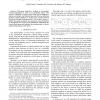Free Online Productivity Tools
i2Speak
i2Symbol
i2OCR
iTex2Img
iWeb2Print
iWeb2Shot
i2Type
iPdf2Split
iPdf2Merge
i2Bopomofo
i2Arabic
i2Style
i2Image
i2PDF
iLatex2Rtf
Sci2ools
CDC
2009
IEEE
2009
IEEE
Design of insulating devices for in vitro synthetic circuits
— This paper describes a synthetic in vitro genetic circuit programmed to work as an insulating device. This circuit is composed of nucleic acids, which can be designed to interact according to user defined rules, and of few proteins that perform catalytic functions. A model of the circuit is derived from first principle biochemical laws. This model is shown to exhibit time-scale separation that makes its output insensitive to downstream time varying loads. Simulation results show the circuit effectiveness and represent the starting point for future experimental testing of the device.
CDC 2009 | Control Systems | Time Varying Loads | Vitro Genetic Circuit | first Principle Biochemical |
| Added | 21 Jul 2010 |
| Updated | 21 Jul 2010 |
| Type | Conference |
| Year | 2009 |
| Where | CDC |
| Authors | Elisa Franco, Domitilla Del Vecchio, Richard M. Murray |
Comments (0)

